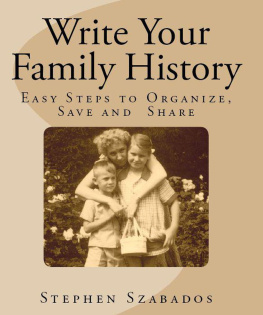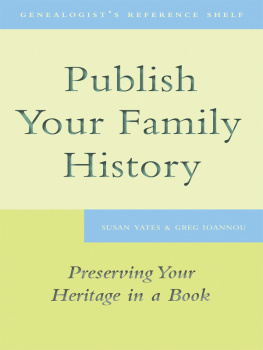
Writing and publishing a family story is a challenging, exhilarating and creative enterprise but it can be a daunting task for the novice.
Ask for help. Become a member of your local family history society. Make every effort to talk to local and family historians in your community. Research how other writers go about their writing and publishing.
Join a writing group. Take part in and visit local and family history research rooms. Search out local printers and digital publishers. Study how others write and publish their books.
The latest versions of genealogy software and other writing software have templates and designs to assist you to construct a book' with these you can collate charts, insert biographical data and images, and add a contents list. However, such software cannot write, edit or publish the book for you. That task finally rests with you. And it is a very worthwhile task preserving your family story in the portable, accessible and relatively inexpensive format of a book allows generations of family members to know their history.
Things to think about
Each chapter in this book presents a series of easy-to-follow steps to help you move from researching and writing your family story to the final printing and publication of a book. It is written with the novice writer/self-publisher in mind, although more advanced researcher/writers will also find it useful. The book introduces the reader to the concepts and strategies offered by new technology but does not ignore traditional means of getting your family story into print.
Some of the issues you face as a self-publisher include grappling with editing; proofreading; page layout; and inserting images, maps and charts. You will need to think about how to construct chapters and choose a title. You will make decisions about what to put in, and what to leave out of the many stories that make up your family's narrative. You will ponder over the writing of biographical entries, trying to ensure they are historically authentic and textually pleasing but often unsure about how to do this. The ever-changing technological maze of self-publishing may at times overwhelm you as you try to shape your family story and, at the same time, make it fit the actual page.
Family historians generally have been quick to use digital technology, the Internet and email. It has been their sustained and meticulous research into and use of early historical records and primary documentary research that has fostered and underpinned the development of online indexes, increased accessibility to state records for all researchers, and the use of computers, printers and new software for recording, writing and producing family history. And, like all writers, family historians have had to keep in touch with changes in book production, as e-book technology and handheld readers enter the market.
Publishing family stories, local history, autobiography, biography, memoir, travel stories and much more via the Internet, on DVD, CD or video, and via other social media is increasingly popular, especially among younger writers. Nonetheless, the physical book has remained a publishing medium of choice for the family historian and for writers in other genres. It is unlikely this will change, although you can add the e-book to the range of possibilities you consider for getting your family story into print.
This book demystifies the process of how to get your family story published. It has practical advice drawn from more than thirty years of my work with family and local historians, and teaching classes on how to write, edit, construct stories and publish family stories, memoir and local history. Indeed there are a great number of different ways of writing and publishing your story and I canvass them throughout this book. And whether you make the decision to stay with a printed book, publish online or create an e-book, you will continue to construct your text in such a way as to appeal to your reader.
The chronicler of family stories begins the writing and publishing journey with many years of research. I have written at length about how historians are drawn to and begin to enjoy this research process. It is one of the most satisfying and personally rewarding tasks you can do. Who wouldn't be excited by the prospect of finding out the fascinating and often intriguing data you discover about your family? How often have you waited with bated breath as your search of an immigration index downloads its precious results? And that skip of a heartbeat as you see for the first time your name, your family name, there in the records telling you so much about the past?
But as much as you love the research, it is not enough. At some point, you will take up your pen and write, and the earlier you do that in the research process the easier the writing will be. Writing as you research is the way to go: if you begin your writing as early as possible, your ability and confidence will improve over time so that you will be better prepared to write the final draft of your book. Further, writing at the same time as you do the research will ensure your research is more focused and more useful for your later history writing, editing and publishing.
Ah yes,' you might say, but in what way do I write, and how do I get started?' In my earlier book Writing Family History Made Very Easy I list specific strategies for getting started with the writing process, and I discuss at length how to write more authentically and vibrantly about characters. I provide advice on how to choose a format and I tell the reader that asking questions, critical questions, leads to the best kind of family story writing. I include strategies and writing exercises for the novice as well as the more advanced writer.
In this book, I take you a step further and map out the strategies to shape your stories, your family memories and your biographies into that bigger story: your family history. In other words, this book is a practical guide to how you move through and from your research, your writing, your ideas and your collected photographs, maps and charts to construct a manuscript that will be readable, interesting and ready for the printer or publisher.
Since the late 1970s, there has been substantial growth in online indexes, increased use of the Internet for the quick downloading of advice and information, and many developments in technologies that support writing and publishing at home. It is relatively easy today to find the software you need to help put together your chapters and there is a plethora of programs, ranging from free or inexpensive software through to the expensive industry standards such as InDesign, QuarkXPress or PageMaker, to help with page layout, scanning images and constructing a book. Nonetheless, despite advances in editing, printing and publishing technology the old adage remains: rubbish in, rubbish out! Your writing and your final story will only work if you take the trouble to construct your text in a credible, interesting way. This book will help you sort through your many ideas and your proposed family story to find the best way to shape your story and produce your book.
Publishing a family story is a unique process. However, it has at its heart a challenge familiar to most writers: how to rein in and shape a coherent story out of the overabundance of collected data now residing on our desks, in our computers and even under our beds! In this book I focus on constructing a family story a family history from a range of source material. However, this model or template can be used to write a memoir, a local history, a story of a business or indeed an account of a personal journey. All of these formats are being used by family historians and all are underpinned by a wide range of family history research.













